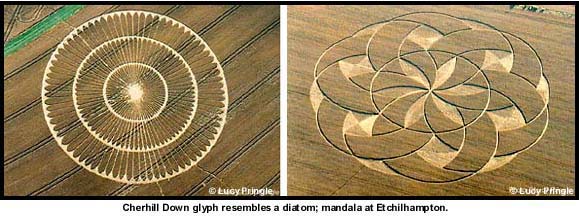
 |
||||||
 |
||||
|
This rotating figure of 75 'spears' is divided concentrically into thirds; each of the tips is generated by a series of tightly interlocking vesica piscis - a geometric figure associated with creation and regeneration (left). Contrary to most crop circles I have dowsed, this particular design seemed to generate no energy beyond its perimeter, the entire energy field being contained within the design. What's more, the lines generated alternating polarities of positive/negative, as did each consecutive ring. And yet the way the plants were laid here left a lot to be desired; the centre was particulalry smashed, although it should be noted that it was several days before I managed access to the site. I also found the alignment of the design relative to the field rather awkward, to say the least (like the Stinehenge 'ribbons' ). In any case, it would appear that, on one level, we are being given the body of a form or an organism this year. There is one more thing to consider in relation to molecules, organisms and DNA. It is interesting that in each succeeding crop circle of this season there lies either a pentagram or a hexagram, veiled or otherwise (for example, the Sompting spiral is defined by a hidden pentagram).
Such a mandala appeared late in the season at Etchilhampton (above), and although at first glance it looks like a series of rotating ribbons in hexagonal form, a concealed pentagram defines the points of intersection (right).Nevertheless I should add that I found the ground detail less than convincing – man made even – but I'll never know because the pattern was harvested the same day. It did not dowse either, which is not a good sign for authenticity. But let us give this the benefit of the doubt: The ratio 5:6 is very crucial here, for it is the ratio that creates an environment for sustaining life on a planet. On Earth, this ratio is determined by the length of Earth's equator in nautical miles relative to its precessional cycle. Rather fitting, therefore, that one of the final crop circles of this season (Ridgeway, below) resembles a 3-D form in the shape of a cross, featuring the four elements of matter plus that which lies above and below (a reference to time and space?). Again, the design was harvested immediately, to the point where no ground analysis was possible, and from the air it has a very mechanical look, the kind you'd expect in man mdae designs. The final design, at Chilton Foliat, also seems to suggest a preoccupation with a molecule in a state of spin (like its predecessor at Normanton). This, too, was harvested immediately after its appearance and so I was unable to look at any physical evidence, although the dowsing response was still there while walking across the stubble. I was able to find several stalks from the Ridgeway glyph where the roots were not pointing downwards and towards the normal gravity centre of the Earth, but instead aligned horizontally, as if the local gravitational field had been altered. I'll have to keep an open mind here as to the authenticity of these latter designs.
For me, this is pretty much where the phenomenon concludes for 2002. The images that follow are a synopsis of other designs that appeared throughout southern England, all of which were hoaxed. With the release of the Disney movie "Signs', people have been inspired to add their expressions to the fields (in fact, it had been rumoured that Disney was sponsoring a wave of hoaxing in lieu of the film's release, both in the US and in the UK). Believe me, the following designs look far better from the air, and are far smaller on the ground than they seem in a photo...
People were seen making this one below Golden Ball Hill; the rotating chevron design at Windmill Hill was simply an appalling waste of good wheat; and at Stanton St. Bernard someone tried to recreate the very complex 'nine spirals' glyph from 1999. And failed miserably. These three are perfect examples of what some have come to call 'crap circles'. ...next page |
||||